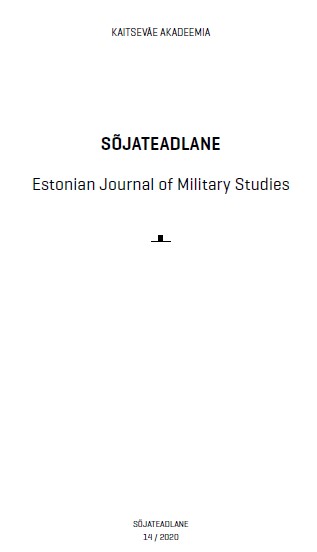MULDADE MÕJU MILITAARSÕIDUKITE MAASTIKULÄBITAVUSELE JA ROOBASTE KUJUNEMISELE EESTI TINGIMUSTES
THE PROPERTIES OF ESTONIAN SOILS AND THEIR EFFECT ON THE SOIL TRAFFICABILITY OF MILITARY VEHICLES AND ON RUT FORMATION
Author(s): Kersti Vennik, Peeter Kukk, Kaarel PiipSubject(s): Security and defense, Environmental interactions, Transport / Logistics
Published by: Kaitseväe Akadeemia (KVA)
Keywords: trafficability; rut depth; military wheeled vehicles; multiple passes; soil properties; soil deformation;
Summary/Abstract: Mobility is a critical capability for the military, and the formation of deep ruts hinders the ability of military vehicles to cross difficult terrains. In the context of military operations, tactical as well logistical vehicles must travel over different types of soils, i.e., arable land, grasslands and peat areas. In this situation, military terrain analysts are tasked with ascertaining the factors that might hinder the trafficability of military vehicles in conjunction with other factors. The primary objective of this paper is to provide a general overview of soil properties, as well as the parameters of wheeled vehicles that influence soil trafficability. Second, this paper presents the results of the rut formation study carried out on different types of soils in Estonia. The aim of the rut formation study was to measure rut depth on different types of soils, and also test the rut prediction ability of pre-compression stress, the SoilFlex compaction model, and different cone penetrometer models. Based on previous research, rut formation is dependent on vehicle wheel load, tyre size and inflation pressure, the number of passes, and the type of movement (e.g., in a straight line vs turning). Additionally, soil texture, moisture, organic matter content, and density are also among the key variables in the estimation of off-road trafficability. The rut formation study was carried out in 2013 and 2014 at seven experiment sites with a 7-tonne military logistics truck, and once also with a 23-tonne armoured personnel carrier (APC). Both test vehicles had equivalent tyre inflation pressures – 650 kPa. The experiment sites covered different types of soil textures (incl. peat soil), as well as different categories of land use (incl. natural grassland and arable areas). The experiments were carried out on days when high moisture content was expected. Test vehicles conducted one and/or ten passes, and rut depth was measured after the first pass and then again after ten passes. In addition, we collected cone penetrometer readings and undisturbed soil samples from right next to the tracks for laboratory analysis with an oedometer. For the purposes of ascertaining bulk densities, soil samples were taken at different depths both from ruts and also from undisturbed areas. After one and ten passes, the highest rut depths were observed on natural grassland soils. Ruts were lower on arable sites which is attributable to the higher mechanical strength of soils in cultivated areas due to pre-compaction resulting from agricultural vehicles. After one pass, the ruts become deeper as a result of passage by a heavier vehicle. After ten passes, the deepest ruts were formed on clay soils.
Journal: Sõjateadlane
- Issue Year: 2020
- Issue No: 14
- Page Range: 163-196
- Page Count: 34
- Language: Estonian

